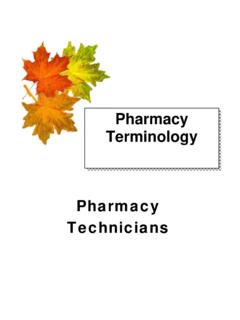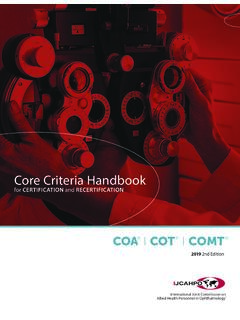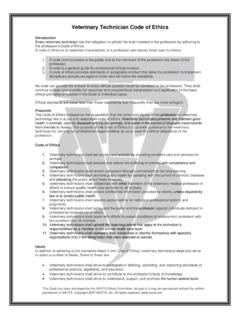Transcription of Pharmacy Technician Training Manual
1 Pharmacy Technician Training Manual Distributed by OPhA 5th Edition, September 2010 2 3 CONTENTS Page 1. Introduction 4 2. Pharmacy Technician Certification Board 5 3. Pharmacy Technician Training Guidelines 6 4. Phase 1 Training 7 5. Phase 2 Training 14 6. Appendixes Appendix 1: Confidentiality of Patient Information 21 Appendix 2: HIPAA 22 Appendix 3: Pharmacy Technician and Supportive 23 Personnel Rules Appendix 4: OBNDD Pseudoephedrine Control 33 Appendix 5: Terminology 37 Appendix 6: Abbreviations 40 Appendix 7:Measurements 41 Appendix 8: Sample Work Schedule 42 Appendix 9: Auxiliary Labels 43 Appendix 10: Definition of the Practice of Pharmacy 45 4 Introduction In May of 1993 the Oklahoma State Board of Pharmacy asked the Oklahoma Pharmaceutical Association (OPhA) to develop a Pharmacy Technician Training Manual .
2 The purpose of the fifth edition of this Manual is to provide pharmacies and pharmacists in the state a Training Manual of Pharmacy material that has been approved by the Oklahoma State Board of Pharmacy . Due to increased quantity of prescriptions in recent years, there has been an increased demand for Pharmacy staff. The increased use of Pharmacy technicians should increase efficiency and quality of pharmaceutical care. However, the pharmacist must live up to the full potential of his or her professional roles and responsibilities. Tech will be the term used for Pharmacy Technician in the Manual . 5 Pharmacy Technician Certification Board Although not required for licensure, some technicians may choose to get certified. Some employers either require certification or may offer incentives for certification.
3 The Pharmacy Technician Certification Board (PTCB) offers a national examination that once passed confers the Certified Pharmacy Technician (CPhT) credentials. This certification increases credibility and adds a level of greater emphasis, responsibility and benefits. The PTCB offers the exam three times a year at nearly 120 sites across the nation. For more information, see Numerous websites offer additional Training materials for the examination. You can learn about the content of the exam and how to prepare by visiting and following the exam link at the top of the page. 6 OKLAHOMA STATE BOARD OF Pharmacy : Pharmacy Technician Training GUIDELINES All Pharmacy technicians must have satisfactorily completed an initial Pharmacy Technician Training Program, Phase 1, prior to receiving a Pharmacy Technician Permit.
4 After receiving the permit, they may begin on-the-job Training (OJT), Phase 2, in the prescription department. This program must be taught in each Pharmacy employing Pharmacy technicians. The development or implementation of a program is the responsibility of the pharmacist manager, who may be requested to submit the instructional text of the Training program to the State Board of Pharmacy for approval. The pharmacist manager, or another pharmacist in the Pharmacy whom he or she may designate, shall conduct the Training and attest to its successful completion. Proof of this Training and subsequent Training must be maintained in the Pharmacy and available for inspection. The Oklahoma State Board of Pharmacy has set these Pharmacy Technician Training Guidelines as minimum standards for Training of Pharmacy technicians.
5 The Training program may be adjusted to meet the specific needs of an individual, but the adjusted program must conform to the minimum standards in these guidelines. 7 Phase 1 (Initial Training ) I. Orientation a. Tour of Pharmacy i. Location of Medications ii. Prescription Files iii. Information Sources iv. Insurance Information v. Other areas deemed appropriate b. Organization Chart (chain of command) i. Describe your store s organizational chart. The pharmacist is always responsible for the tasks the Technician completes. c. Policy and Procedures Manual (if one exists) i. The development of a policy and procedure Manual is highly recommended. d. Confidentiality of Patient Information i. See Appendix 1 e. Health Insurance Portability and Accountability Act of 1996. (HIPAA) i. See Appendix 2 f.
6 Patient Information Literature i. There are several prescription medications that require patient package inserts when a prescription is dispensed. Examples are Premarin, birth control pills, etc. Other useful information to help instruct a patient is also available. The tech should be able to help the pharmacist in maintaining these sources of information. g. Reference Sources i. The tech should know: 1. Where the reference books are located in the Pharmacy 2. Legal requirements pertaining to keeping an updated Pharmacy library. (See Rules and Regulations section of current Law Book) h. Name Tags i. The public should be able to distinguish the pharmacist from any support personnel in the Pharmacy . All support personnel must be distinctly identifiable from a practicing pharmacist. Name and job title should identify Tech from other support personnel.
7 I. Dress Code i. Each Pharmacy should determine the dress code, however in general a clean and professional appearance is desired. II. Job Description a. Role of Pharmacist i. The pharmacist is responsible for all judgmental tasks involved in dispensing a prescription and for maintaining good pharmaceutical care. 8 ii. The pharmacist is responsible for all counseling and shall not delegate this task to anyone. An intern is allowed to counsel if deemed appropriate by the pharmacist. iii. The pharmacist may delegate non-judgmental tasks to be done, but the responsibility, both legally and professionally, stays with the pharmacist. iv. The pharmacist s duties are a provision of those acts or services that are necessary to provide pharmaceutical care. b. Role of Support Personnel i. The supportive personnel may perform tasks other than those of a pharmacist or Technician .
8 Ii. See appendix 3 for an excerpted portion of the Oklahoma Pharmacy Law Book pertaining to duties of technicians and supportive personnel. c. Role of Pharmacy Technicians i. May perform any duties supportive personnel are allowed to perform ii. Count and/or pour medications iii. Prepackage and properly label medications ( unit dose) iv. Affix auxiliary labels to the container as directed by pharmacist. v. Affix the prescription label to proper container vi. Reconstitution of medication ( liquid antibiotics) vii. Bulk compounding, including such items as non-sterile topical compounds, sterile irrigation solutions and products prepared in relatively large volume for internal or external use. Documentation of a system of in-process and final checks and controls must be developed or approved by the certifying pharmacist and carefully and systematically enforced.
9 Viii. May perform functions involving reconstitution of single dose units of parenteral products that are to be administered to a given patient as a unit, and perform functions involving the addition of one manufacturer s prepared unit (whole or part) to another manufacturer s prepared unit, if the unit is to be administered as one dose to a patient. The pharmacist must establish procedures for parenteral products and certify the ingredients, and label the finished product. ix. May assist the pharmacist in the annual Controlled Dangerous Substance inventory. The pharmacist remains responsible for completeness and accuracy. d. Personal Attributes i. Self Confidence: Knowing when and whom to ask for help is part of self-confidence. ii. Knowledge: Using the Training given, the tech may help the pharmacist in knowing a patient and remembering what has occurred in the past regarding the patient.
10 9 iii. Sincerity: The combination of honesty, common sense and diplomacy may be characterized as sincerity. Show concern for the patient. iv. Concern for others: A concern for others, coupled with empathy, open-mindedness and understanding of their opinions or situation is important. Try to look at their point of view. Are there other helpful options? v. Tact: Tact is an important aspect of verbal communication in any Pharmacy . e. Pharmacy Technicians interrelationships with: i. Pharmacists: All tasks performed by the tech are the ultimate responsibility of the pharmacist. The tech works under direct and immediate supervision by the pharmacist, as stated in the State Board Rules. The tech should present any problems or discrepancies to the pharmacist. ii. Patients: The tech should be courteous and tactful when obtaining information.









